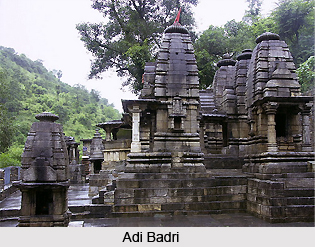 Adi Badri is an ancient temple in Chamoli District of Uttarakhand and amongst the series of 16 tiny shrines present in mountainous tracts, close to the intersection of Alaknanda River and Pindar River, which is popularly known as `Karnaprayag`. Its geographical coordinates are 30 ° 17 minutes North and 77 ° 20 minutes East and is believed to be the first temple which was constructed, as part of the Sapta Badri temples during the period between 5th to 8th century, in the Gupta era by Adi Shankara. Also referred to as `Helisera`, this shrine in the state of Uttarakhand occupies an area measuring 14 metres, whose height measures about 98 feet and is dedicated to Lord Vishnu.
Adi Badri is an ancient temple in Chamoli District of Uttarakhand and amongst the series of 16 tiny shrines present in mountainous tracts, close to the intersection of Alaknanda River and Pindar River, which is popularly known as `Karnaprayag`. Its geographical coordinates are 30 ° 17 minutes North and 77 ° 20 minutes East and is believed to be the first temple which was constructed, as part of the Sapta Badri temples during the period between 5th to 8th century, in the Gupta era by Adi Shankara. Also referred to as `Helisera`, this shrine in the state of Uttarakhand occupies an area measuring 14 metres, whose height measures about 98 feet and is dedicated to Lord Vishnu.
The small shrine of Adi Badri is situated about 3 km from the fort of Chandpur. Adi Badri shrine is easily accessible from Karnaprayag, which is an hour`s drive from this holy shrine. It is existent enroute to Ranikhet and is situated near Chulakot. The idol of Lord Vishnu is represented by an image made of black stone measuring about a metre, wherein a discus or `chakra`, lotus or mace is held by the idol. Brahmins belonging to southern India are the priests of this temple. According to a mythological prophecy, the Adi Badri shrine would be referred to as `Yog Badri`, following the future alteration of the sacred abode of Lord Badrinath to Bhavishya Badri, after the blocking of the pathway to Badrinath. The 16 temples present near Adi Badri are similar to the temples located at `Dwarghat` in Almora.
The Lake of Benital is also found close to Adi Badri. The remnants of 16 temples are also present near this site which are said to have been created during the Gupta age. These temples are clustered together, which has created a space measuring about 12.5 metres. Adi Badri is one of the five famous Badris known as Bhavishya Badri, Vriddha Badri, Vishal Badri and Yog-Dhyan Badri, the Panch Badri. There is a raised platform at the front of Adi Badri shrine that connects to a tiny enclosure of a pyramidal form, exactly at the location of the idol of Lord Vishnu.



















